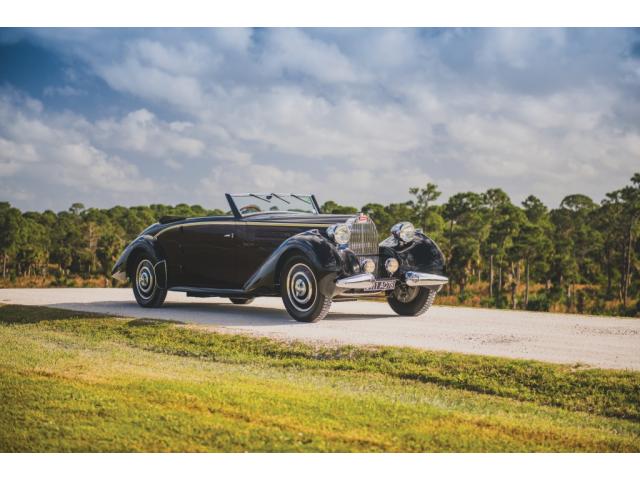1938 Bugatti Type 57 Drophead Coupe
- Brand: Bugatti
1938 Bugatti Type 57 Drophead Coupé Coachwork by Albert D'Ieteren
Ettore Arco Isidoro Bugatti was born in Milan, Italy in 1881. His father, Carlo, was a furniture designer of some fame. The father's brother, Rembrandt, was a gifted sculptor of animals. When he was old enough, Ettore attended the Brera Academy of Art where he studied sculpture. Soon, he turned his attention to mechanical endeavors.
The first Bugatti motor car was built in 1899 though the first vehicle to bear his name was the Type 13 of 1910. Power came from a four-cylinder, eight-valve engine. The 1913 the radiators became more rounded and in the shape of a horse shoe.
The company's first eight-cylinder engine production car was introduced in 1922 and dubbed the Type 30. The engine had a single overhead camshaft and displaced two liters. The car had a drum brakes, solid axles and leaf springs on all four corners.
The Type 35 in all sequences, the A, B, C, and T, were some of Bugatti's early examples that made the marque famous. The Type 57 introduced in 1934 and continued in production until 1940. They were powered by a 3257cc straight-eight engine with double overhead camshafts that produced between 130 and 140 horsepower. There were four road-going versions of the 57 and these were the Type 57, Type 57C, Type 57S, and Type 57SC. The Type 57C was a supercharged version while the Type 57S was a sporty version based on a short and lower wheelbase. The Type 57SC was a combination of the 57S and 57C. A variety of body-styles were offered throughout the years.
The engine rested in a ladder-type frame and matted to a four-speed manual gearbox. The front had a tubular axle with the suspension comprised of longitudinally mounted semi-elliptic leaf springs. The rear axle was suspended in place by a pair of quarter-elliptic leaf springs. The early versions of the vehicle had cable-operated drums on all four wheels. Later versions were upgraded with Lockheed hydraulic brakes with twin master cylinder, which first appeared in 1938.
The Type 57 and its variants were intended for road going use. However, many made their way onto the racing circuit. Lord Howe drove a Type 57 to a third place finish in the 1935 Tourist Trophy. A Type 57G won the Monthlhery and Reims race in 1936. In 1937, Jean-Pierre Wimille and Robert Benoist drove a Bugatti to victory at LeMans.
Many of the cars were clothed by prominent coachbuilders such as Figoni, Van Vooren, Corsica, and James Young. Most of the chassis were bodied by the factory with coachwork in the style of Jean Buggatti. The catalog bodies included two versions of the Ventoux Coupe, the Galibier four-door sedan, the Stelvio cabriolet, Atalante, and Atlantic. The Atlantic and Atalante were constructed in two-door coupe configuration. Gangloff, a Swiss coachbuilder, was tasked with clothing most of the factory bodies.
The coachbuilding firm of D'Ieteren was founded in 1805 by Jean Joseph D'Ieteren, who started his career as a wheel-wright. Thus D'Ieteren, which is located in Brussels and still exists today, is one of the oldest automotive firms in the world. From 1897 to 1935 the firm built something like 6,000 high-quality coachworks on chassis from Hispano Suiza, Minerva, Mercedes-Benz, and Bugatti. It counted Dutch and Belgian royalty amongst its clients. Sadly just 30 to 40 of those magnificent cars have survived. This is the only Type 57 Aravis Known to have been bodied by Albert D'Ietern. It was delivered on March 9, 1938, to its first owner, a Mr. Baggage.
The Cabriolet coachowrk on this Bugatti was inspired by Letourneur et Marchand's three-seater chassis no. 57826. Mr. Baggage was a tall individual resulting in the somewhat stretched cabin proportions. There is a low, sleek and streamlined folding canvas top and roll-up windows.
Descriptions & pictures by conceptcarz & bonhams & wheelsage & other
| Specification | |
| Production Start | 1938 |
| Country of origin | Italy |













